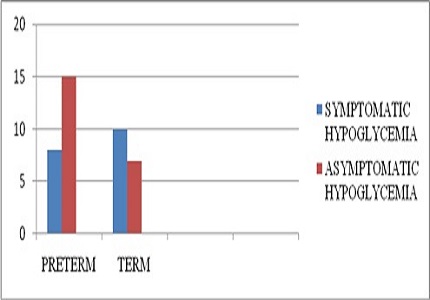Study of incidence, clinical profile and risk factors of neonatal hypoglycemia in a tertiary care hospital
Abstract
Background: The reported incidence of hypoglycemia varies with its definition. The clinical manifestations of hypoglycemia are nonspecific and similar to those of many disorders in newborn infants. Persistent hypoglycemia is more likely to be associated with possible neurologic sequelae. However, its definition, clinical significance, and management remain controversial.
Methods: This prospective observational study was done over a period of 2 years. Babies admitted to Neonatal intensive care unit with whole blood sugar levels <40 mg/dl and fulfilling inclusion criteria were taken up for the study. These babies were subjected to detailed history taking, thorough clinical examination and investigations. The babies were observed for signs and symptoms of hypoglycemia.
Results: Neonatal hypoglycemia constituted about 8.26%. Majority of hypoglycemic babies were preterm babies. Asymptomatic hypoglycemia was predominantly noticed in preterm babies (65.21%). Term babies (58.82%) showed more symptoms with hypoglycemia than preterm babies. The major clinical manifestations are jitteriness, lethargy, convulsions and apneic spells. PIH and prematurity are most associated risk factors. Significantly low Sugar levels (p value <0.005) were noticed in symptomatic hypoglycemic babies.
Conclusion: Hypoglycemia in neonates can have variable presentations indicating the need for detailed and thorough examination for evidence of hypoglycemia. Identification of risk factors of hypoglycemia and proper monitoring blood glucose levels should be done to plan early treatment and prevent neurological damage.
Downloads
References
2. Richard E. Wilker, Hypoglycemia and Hyperglycemia In: John. P. Cloherty, Eric C. Eichenwald, Ann R. Stark editors. Manual Of Neonatal Care. 6th Ed. Philadelphia: Wolters Kluwer; 2010. p. 540- 546.
3. Satish C. Kalhan, Prabhu S. Parimi. Metabolic and Endocrine Disorders. In: Richard J. Martin, Avory A. Fanaroff, Michele C. Walsh editors. Fanaroff and Martins Textbook, Neonatal- Perinatal Medicine. 8th ed.,vol 2, Mosby Elsevier; 2006. p. 1467-1480.
4. Najati N, Saboktakin L. Prevalence and underlying etiologies of neonatal hypoglycemia. Pak J Biol Sci. 2010 Aug 1;13(15):753-6. [PubMed]
5. Ghaemi Nosrat, Mohammadzadeh Ashraf, Farhat Ahmad Shah. Incidence and etiology of hypoglycemia in neonatal intensive care unit admissions. Journal of Chinese Clinical Medicine. 2009; 4(6): 321-324.
6. Dhananjaya CD, Kiran. B. Clinical profile of hypoglycemia in newborn babies in rural hospital setting. Int J Biol Med Res. 2011; 2(4): 1110 – 1114.
7. Dorina Rodica Burdan, Valentin Botiu, Doina Teodorescu. Neonatal hypoglycemia. The incidence of the risk factors in Salvator Vuia obstetrics gynecology hospital, Arad. TMJ. 2009; 59(1): 77-80.
8. Sasidharan CK, Gokul E, Sabitha S. Incidence and risk factors for neonatal hypoglycaemia in Kerala, India. Ceylon Med J. 2004 Dec;49(4):110-3. [PubMed]
9. Inayatullah Khan, Taj Muhammad, Muhammad Qasim Khan. Frequency and clinical characteristics of Symptomatic Hypoglycemia in neonates. Gomal Journal of Medical Sciences. 2010 Jul; 8(2): 117-120.
10. Nasrin Dashti, Nahid Einollahi, Sakineh Abbasi. Neonatal hypoglycemia: Prevalence and clinical manifestations in Tehran Children’s Hospital. Pak J Med Sci. 2007; 23(3):340-343.

Copyright (c) 2016 Author (s). Published by Siddharth Health Research and Social Welfare Society

This work is licensed under a Creative Commons Attribution 4.0 International License.


 OAI - Open Archives Initiative
OAI - Open Archives Initiative


